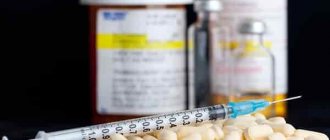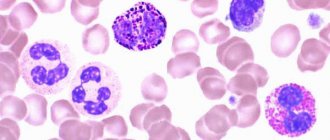What is formaldehyde
Formaldehyde is a chemical compound that has a pungent odor, can dissolve in liquids and ignite. Formalin is a 40% aqueous solution of formaldehyde.
The chemical characteristics of the poison pose a threat to human health and life. If you drink formaldehyde in an amount of 35 to 90 mg, you can die.
The substance is produced industrially by the oxidation of methanol. Formalin belongs to the first class of danger, as it can affect the cellular level. The poison can penetrate into internal organs as a result of chemical interactions that have occurred, and can also be formed in living organisms from other substances. Methanol is found in many household chemicals.
A person is regularly exposed to negative fumes, but a single inhalation of formaldehyde, as a rule, does not provoke serious consequences.
The smell of formaldehyde is extremely pungent and unpleasant.
However, detecting poison on your own is almost impossible: this requires special instruments and reagents. The smell of formaldehyde can be described as specific. At the moment, pharmacy chains sell the antiseptic “Formidron”, which contains formaldehyde. Use the product carefully, avoiding inhalation of vapors.
The permissible dose of the substance is up to 0.2% in cosmetics and up to 0.1% in mouth rinses. In medicines its content should not exceed 0.5%. Products containing 5% of this compound can also be used, but are contraindicated for use on the face.
The maximum permissible concentration in cosmetics, in particular shampoos and bathing foams, is 0.1%, with only 1 person out of 75,000 experiencing a negative skin reaction.
As follows from the description, formaldehyde is one of the dangerous poisons that can disrupt the functioning of internal organs and cause human death.
FORMALDEHYDE SOLUTION. Solutio formaIdehydi.Synonym: formaldehyde.
Contains 36.5-37.5% formaldehyde.
Properties.
It is a transparent, colorless liquid with a peculiar pungent odor, soluble in water and alcohol in any ratio. Incompatible with oxidizing agents, camphor, menthol, thymol and resorcinol. It is stabilized by adding methyl alcohol, but not more than 1%.
Release form. Produced in well-closed glass or metal containers.
Store in a place protected from light, at a temperature not lower than 9°C. During long-term storage in the cold, formaldehyde undergoes polymerization to form paraformaldehyde, which precipitates in the form of white flakes that disappear when heated.
Action and application.
Formaldehyde has a pronounced antimicrobial effect due to its ability to attach to the amino groups of protein molecules, and is also a good deodorizing agent due to its ability to bind ammonia in the air. In high concentrations it has an astringent and cauterizing effect on the mucous membranes.
In case of acute poisoning of cattle with urea, the effect of formaldehyde is that it binds ammonia in the rumen to form non-toxic hexamethylenetetramine, inhibits the urease enzyme, slowing down the hydrolysis of the remaining urea, and lowers the pH of the contents, preventing further absorption of unbound ammonia. With a single injection into the scar, the effect of the drug lasts for 1 hour.
Formaldehyde solution is indicated for the treatment of cattle with urea poisoning.
To treat sick animals, the drug is prepared by dissolving a therapeutic dose of official formaldehyde solution (0.3 ml per 1 kg of live weight) in 1 liter of water. For example, if the animal’s body weight is 500 kg, then to prepare the drug, take 150 ml of formaldehyde solution (0.3 ml x 500 kg) per 1 liter of water.
When clinical signs of animal poisoning with urea appear, the drug is administered once into the rumen through the wall in the area of the left hungry fossa using a Janet syringe using a 10-12 cm long needle.
At recommended doses it does not cause side effects or complications. In excessive doses, after administration it can cause slight depression, trembling of the body muscles, and hypotension of the forestomach. The side effects of formaldehyde solution can be reduced by administering protein orally, gastric lavage with a suspension of activated carbon, and introducing ammonium acetate into the rumen at a dose of 15-25 g.
In case of acute poisoning of cattle with urea, there are no contraindications to the use of formaldehyde solution.
Formaldehyde reacts well with many substances, including proteins. It has an irritating, cauterizing, antimicrobial, antiparasitic, deodorizing and drying effect. Kills non-spore-forming microorganisms, spore forms of microbes, viruses and fungi. Anthrax spores die within three hours when exposed to a warm (30°C) 4% formaldehyde solution. It has a detrimental effect on scabies mites, flies, their larvae and other parasites. Increasing the temperature and relative humidity in the premises increases the antimicrobial activity of the drug. The antimicrobial action is based on the interaction of formaldehyde with protoplasm and the removal of oxygen from protein compounds, coagulation and denaturation of the bacterial cell protein. At temperatures below 0°C, formaldehyde has no harmful effect on microbes.
Formalin thickens and dries out the skin, and with frequent use, the skin becomes dry, brittle and eczema develops. Aqueous solutions of formaldehyde, after oral use, have an antiseptic and anti-fermentation effect, and in cases of ingestion of concentrated solutions, gastroenteritis develops.
Used as one of the most versatile and best means for disinfecting livestock buildings. Can be used in aqueous solutions, in a gaseous state, in the form of aerosols, both in pure form and in mixtures with other chemicals. To disinfect premises for foot-and-mouth disease, Aujeszky's disease, pasteurellosis, swine erysipelas, poultry pullorosis, use a 1% solution of formaldehyde; for infectious vaginitis, swine paratyphoid fever, swine fever, sheep pox, washing horses - 2%, for anthrax - 4% solution. An alkaline solution of formaldehyde is recommended for disinfection for dermatomycosis (1% caustic soda and 2% formaldehyde), and for avian tuberculosis (3% caustic soda and 3% formaldehyde). Disinfection is carried out at a temperature of 25-30°C.
Formaldehyde is used for gas disinfection of hermetically sealed premises, containers and equipment. To do this, pour 45 parts by weight of formaldehyde (40% formaldehyde) and 22 parts of water into a metal or porcelain bowl, and then add 30 parts of potassium permanganate. The staff leaves the premises and closes it. When formalin interacts with potassium permanganate, a violent reaction occurs, accompanied by high temperature, as a result of which formalin quickly boils and evaporates. For disinfection, take 40-50 ml of formaldehyde (40% formaldehyde) per 1 m3 of room at a temperature of 25-30°C, relative humidity 70% and exposure for 5-6 hours. After this, the room is thoroughly ventilated.
In this way, hard containers (cages, boxes, shovels, forks, etc.), soft equipment and workwear are disinfected in steam-formalin chambers. The required relative humidity (65-70%) and temperature (60°C) are created in the chamber; formaldehyde consumption is 40-50 ml per 1 m3 with exposure for one hour. At the end of disinfection, to neutralize formalin, half the amount of ammonia is introduced into the chamber and after 5 minutes the chamber is unloaded. To disinfect the spore form of pathogens, the amount of formalin is increased to 100 ml per 1 m3.
To disinfect premises, formaldehyde can be used in an aerosol form at the rate of 20 ml of formaldehyde (40%) per 1 m3 with an exposure of 5-6 hours. For simultaneous disinfection and disinsection, take formalin with the addition of 5% chlorophos or 0.1% DDVP. For tuberculosis and spore forms of microorganisms, 40 ml of formalin is consumed per 1 m3. For disinfection barriers and disinfectants, an alkaline formaldehyde solution containing 3% formaldehyde and 3% sodium hydroxide is used.
To disinfect vehicles or other equipment in areas of foot-and-mouth disease, a 2% formaldehyde solution or formaldehyde aerosol is used at the rate of 60 ml of a 40% formaldehyde solution per 1 m3 of room with an exposure of 30 minutes. Car wheels are disinfected in disinfection barriers filled with an alkaline solution of formaldehyde (3% sodium hydroxide and formaldehyde). For foot rot of sheep and goats, after trimming the hooves, the animals are passed through a foot bath with a 10% formaldehyde solution or a 5% paraform solution. In this case, disinfection of premises, pens, equipment, care items, vehicles and surgical instruments is carried out with a 10% formaldehyde solution or a 5% paraform solution. The same solution is used in the form of foot baths to prevent foot rot in apparently healthy sheep and goats. A 3% formaldehyde solution is recommended for disinfection of fish farming facilities (tanks, tubs, carts, etc.). For aerosol disinfection of meat processing plants infected with the foot-and-mouth disease virus, a 20% formaldehyde solution of 30-40 ml per 1 m3 with an exposure of 2 hours is recommended.
Formalin is used as a disinfectant and deodorant for washing hands, disinfecting instruments (0.5% solution), for douching (0.05% solution); sterilization of cotton and linen threads and catgut (threads are immersed in a 4% solution for 24 hours, and catgut for 72). A 2.5% alcohol or aqueous solution of formaldehyde in the form of gauze applications is prescribed for necrobacillosis (at the onset of the disease or in the gangrenous form). For necrobacillosis, a liniment consisting of equal parts of formalin, creolin and tar is recommended. For frostbite of the third degree, it is recommended to apply an anti-gangrenous liquid consisting of formalin (5 parts), tricresol (5 parts) and distilled water (10 parts). A 5% alcohol solution of formaldehyde is used to treat the surgical field.
Formalin is used to preserve pathological material, vaccines and some serums.
To disinfect the premises of rabbit farms and complexes, use a 1% formaldehyde solution, as well as an aerosol from a 36-40% formaldehyde solution at the rate of 10 ml per 1 m3 of premises with an exposure of 6 hours. Then the room is ventilated and excess formaldehyde is neutralized with an ammonia solution. Vehicles in complexes, equipment for caring for rabbits, as well as premises at beef production enterprises are disinfected with a 2% formaldehyde solution. Pre-launch disinfection of enclosed spaces is carried out with formaldehyde aerosols (36-40%) at the rate of 20 ml per 1 m3 of room with exposure for 24 hours.
Scope of application
The substance is used primarily in medicine and industry. This compound is included in nail polishes and hair care products. A small dose of it is included in some cosmetic preparations as a disinfectant and preservatives, and is included in creams, deodorants, shampoos, and mouth rinses.
Sources of poisoning by chemical compounds are divided into several hazard classes based on their properties. Formaldehyde is a strong toxin, has the ability to explode, and has a negative effect on humans upon internal penetration.
There are a large number of sources of intoxication. These include:
- gas stoves;
- vehicle exhaust gases;
- glue;
- medicines;
- household chemicals;
- cosmetics;
- carpets;
- smoke from tobacco and electronic cigarettes;
- fertilizers and others.
The maximum concentration is observed at high humidity and high temperatures.
The properties of formaldehyde are used to disinfect medical equipment and devices, to sterilize objects, treat diaper rash and skin lesions, and reduce sweating.
The use of formaldehyde is exclusively external: inhaling and drinking the solution is extremely dangerous to life. It is used for local disinfection, as a deodorizing and astringent. In addition, a diluted solution is used for douching.
The substance is most often found in the chemical industry, in the production of paints, paper products, resins, textiles and plastics. The compound has also found its use in the wood processing industry, in the manufacture of floor coverings, in the processing of animal skins, as an antiseptic and antimicrobial agent, and in the production of yeast.
Indications
The product is used for medical purposes and as a disinfectant liquid for the following pathologies and situations:
- For obvious sweating
- For unpleasant foot odor
- For douching
- When disinfecting hands
- For the purpose of disinfection of medical devices, equipment, tools
- For the treatment of animals with carbamide poisoning
- When infected with non-spore-forming parasites in veterinary medicine
- For disinfection of livestock buildings
- When preserving biological pieces of material, serums, vaccines
- For embalming fabrics.
Impact on humans
The effect of the compound on the human body is extremely unfavorable: it can cause severe poisoning and is equivalent to arsenic intoxication. Under the influence of vapors, the brain, respiratory system, and mucous surfaces suffer. The harm of formaldehyde to humans is severe intoxication of internal organs. The most severe consequences include:
- swelling of the pulmonary system and larynx, causing difficulty breathing, respiratory failure, which often causes death;
- kidney inflammation;
- menstruation and endocrine disorders leading to the inability to conceive in women;
- difficulty urinating, leading to coma;
- death of the mucous membranes of the stomach and esophagus;
- internal hemorrhage.
Is formaldehyde harmful to humans? This question can definitely be answered positively.
With regular inhalation of vapors, a person may become more sensitive to the poison, which ultimately leads to more serious complications.
In addition, the poison negatively affects internal organs: liver, kidneys, respiratory and visual systems, and is also a powerful allergen. Formalin has a carcinogenic effect on the fetus, leading to cell mutation, destroying nerve tissue and optic canals. Having penetrated the bloodstream, it reacts with blood proteins and is synthesized into formic acid, which is difficult to remove from internal organs.
What is the effect of formaldehyde on children? Babies are the most sensitive to the world around them, which is why a carcinogen can have a significant impact on their body. With continuous interaction with dangerous objects, even a small concentration of it can provoke serious complications. The substance may be contained in children's toys, teethers, pacifiers, stickers, and plastic baby dolls.
Histology
Making preparations involves fixing the material, creating sections, and staining the tissue. The essence of the process is protection from rotting and fermentation. An alcohol-based solution of Formalin is diluted with water in a concentration of 10 to 90 parts. Within 72 hours, the fabrics are impregnated and fixed with high quality. In stronger dosages, the pieces become denser and become covered with a crust, which prevents deep self-destruction. To avoid the release of formic acid, the product is neutralized with chalk. For accelerated research, the liquid is heated to 800C.
Consequences of poisoning
A carcinogen can enter the human body in the following ways:
- by inhalation;
- orally;
- by direct interaction with the skin.
It is worth noting that the distribution of this compound throughout the body is uneven. It deposits most intensively in the following internal organs:
- pancreas;
- mucous surfaces of the intestinal system;
- lymph;
- salivary glands;
- bone marrow.
If accidentally or intentionally ingested, people may develop:
- severe renal failure;
- liver pathology, characterized by the destruction of its cells;
- bleeding of the mucous surfaces of the stomach;
- necrosis of the esophagus.
Formaldehyde can be irritating to the respiratory system and lead to the following pathologies:
- bronchitis;
- pulmonary obstruction;
- exacerbation of bronchial asthma.
When interacting with the skin, the compound can provoke:
- dermatitis, which often becomes chronic;
- hives, rash;
- destruction of nails;
- redness and burning;
- weeping eczema.
The substance can destroy the immune system, provoke changes in blood composition, reduce the levels of lymphocytes and immunoglobulin A, so the dangers of formaldehyde should be known to anyone who wants to protect themselves from the effects of poison.
Analogs
Various preparations with antiseptic, antimycotic and disinfecting properties are prepared on the basis of Formalin:
Lysoform
Medical Lysoform, Ukraine
Cost: Spray 250 ml – 180-200 rubles. Size 1000 ml – 500-550 rub.
Lysoform is presented in the form of an antiseptic, which is used to treat the skin of the feet in case of infectious diseases, eliminates excessive sweating, and deodorizes. Used for disinfection of instruments and equipment. Consists of 40% formalin, 40% potassium soap solution, 20% alcohol.
Using the medication, douching is done and the burn areas are lubricated. The medicine disinfects lesions of the epidermis with exudate from furunculosis, eczema, and helps eliminate mycoses. For use only in diluted form.
The solution is yellowish, transparent. Bottled in plastic bottles with a sprayer of 250 ml. The second form of release is 1000 ml propylene cylinders, the kit includes a spray bottle. Each bottle has a label with instructions. The smell is pungent and specific.
Advantages:
- Doesn't dry out the skin and is gentle.
- Convenient to use bottle.
Flaws:
- Not prescribed for pregnant women and children.
- Cannot be applied to the face.
Formidron
JSC YaFF, Russia
Cost: Solution 50 ml – 20-25 rubles. 100 ml – 30-35 rub.
The drug has an antiprotozoal and deodorizing effect, which determines its use for sweating. Thanks to the formaldehyde contained in the composition, it eliminates unpleasant foot odor and destroys mycotic spore cells. Used to disinfect shoes for preventive purposes. Contains the active ingredient, ethanol, water and fragrance.
To treat with the product, moisten a swab and treat the affected areas twice a day until the symptoms disappear. If irritation, rash, peeling, itching on the epidermis is observed, use should be stopped immediately.
Available in dark brown bottles of 50 and 100 ml. The liquid is clear, with a characteristic strong odor. The bottles are placed in cardboard boxes along with instructions. Each container is tightly closed with a polyethylene stopper and lid.
Advantages:
- Quickly eliminates unpleasant odor from feet and shoes
- Affordable price.
Flaws:
- May dry out skin
- Sometimes it causes a burning sensation when processed.
Symptoms of intoxication
Formaldehyde poisoning may have some characteristics, mainly from the brain and respiratory organs. These include:
- attack of suffocation;
- coughing;
- difficulty breathing;
- itching and burning of the mucous surfaces of the esophagus and larynx;
- diarrhea and vomiting with blood streaks;
- intense thirst;
- pale skin;
- mood swings;
- prostration;
- sleep disturbance;
- convulsive syndrome;
- coordination disorder;
- headache;
- weight loss.
In people who frequently come into contact with poison, signs may manifest themselves in the form of allergic reactions, hives, and brittle nails. In women there is a disruption in menstruation, in men there is a decrease in libido.
High concentrations can lead to toxic shock, coma, and death.
Who's at risk
The following categories of the population are most susceptible to the effects of the carcinogen:
- people involved in the chemical industry;
- living near chemical plants;
- workers in workshops for the production of furniture, paper, sewing accessories, food additives;
- medical laboratory technicians;
- morgue workers;
- people whose activities involve embalming corpses and funeral services.
In addition, a connection has been established between formaldehyde and cancer: it is considered a strong carcinogen.
Studies regarding formaldehyde have found that workers involved in embalming corpses and making furniture are more prone to skin cancer, tumors of the respiratory system, and tumors in the stomach, lungs, prostate, and intestines.
People engaged in potentially hazardous production for more than 10 years are at increased risk for the following malignant diseases:
- Hodgkin's lymphoma;
- myeloma;
- myeloid leukemia.
It has been established that the substance acts directly on cells, which provokes gene mutation.
Storage and disposal rules
The product must be kept in a closed place, the bottles must be carefully sealed. Shelf life - no more than two years at temperatures up to 90 C.
The drug must not be poured into the sewer. In medical institutions there are special containers for biological waste. At home, it is recommended to first neutralize the solution using hydrogen peroxide, ammonia or copper hydroxide. After this, disposal can be carried out in carefully packed containers.
First aid and treatment
In case of food poisoning that contains formaldehyde, the victim must be taken to the hospital by calling medical professionals. If necessary, if the patient requires immediate assistance, emergency measures will help:
- remove remaining poison from the stomach by lavage or inducing artificial vomiting;
- the patient needs to take activated carbon at the rate of 1 tablet per 10 kg of weight, having previously dissolved it in water. The stomach should be emptied within 2 hours;
- in case of intoxication, it is necessary to provide the person with a flow of fresh air by opening windows and doors wide or take the victim outside;
- will help neutralize the effect of inhalation poison with water and ammonia, which can remove an excess of the compound;
- if the carcinogen penetrates the skin and mucous membranes, they should be washed abundantly with water and wiped with ammonia;
- in case of contact with the organs of vision, the eyes are instilled with drops of the following composition: 8 drops of adrenaline and 2 drops of novocaine, which can neutralize the poison;
- when swallowing the solution, chloride or ammonium carbonate will help, which prevent the compound from being absorbed into the circulatory system;
- if the patient has lost consciousness, he is placed on his left side to avoid penetration of vomit into the respiratory system and suffocation.
The victim is advised to drink plenty of fluids, as well as use ammonia-anise drops. To prevent liver failure or kidney failure, a glucose-novocaine solution is used.
Treatment methods for formaldehyde intoxication depend on the characteristics of the clinical picture, the mechanism by which the poison enters the internal organs, as well as the symptoms that appear.
In some cases, medications are used that stabilize the functioning of the heart and blood vessels, sedatives, and respiratory analeptics.
In a hospital setting, the victim can undergo hemodialysis, in which blood is passed through membranes, which is an effective measure to eliminate toxins.
An isotonic solution or glucose is injected into the patient’s veins together with a diuretic. In addition, specialists need to monitor the functioning of the central nervous system and heart. To prevent liver disorders, vitamin complexes and hepatoprotectors are used.
Overdose
In case of severe poisoning, lesions are observed due to the penetration of toxic vapors and elements into the blood. As a result of the cauterizing properties, tissue death develops.
In severe cases, severe intoxication with impaired renal and liver function was observed.
Exceeding the concentration when disinfecting premises or treating feet is accompanied by lacrimation, spasms of the respiratory organs, and burns of the integument. When ingested, drugs based on urea and ammonia act as an antidote. You cannot induce vomiting. Cleaning the digestive organs is carried out only with the help of a special probe.
In case of vapor poisoning, inhalation with ammonia is prescribed.










